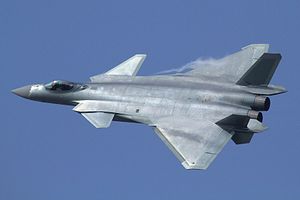Upon entering service in 2017 the Chengdu J-20 became the first active fifth generation fighter jet in the world developed outside the United States — providing the Chinese People’s Liberation Army Air Force (PLAAF) with an analogue to the U.S. Air Force’s F-22 Raptor air superiority fighter. The J-20 was designed with a radar evading stealth profile to maximize its survivability both in air-to-air combat against enemy fighters and against enemy air defenses. The fighter’s air superiority airframe provides it with a high thrust/weight ratio, a high speed, high operational altitude, and the long range needed to dominate airspace both over Chinese territory and beyond across the South and East China Seas. Recent reports from Chinese state media outlet CCTV however indicate that the J-20 airframe could potentially be modified to fulfil different roles for the PLAAF — namely that of an electronic attack and a strike aircraft.
The PLAAF has increasingly relied on modifying airframes of high performance combat aircraft to perform specialized roles – a lower cost alternative to developing new airframes altogether. The J-11B airframe, for example, was developed into an advanced strike fighter, the J-16, and the J-16 was itself in turn developed into an electronic attack jet, the J-16D. The J-15 carrier based air superiority fighter has also been developed into an electronic attack aircraft, the J-15D (or J-17), while the JH-7 strike fighter and H-6 bomber have undergone similar modifications. Alongside an electronic attack role, some H-6 bombers have also been developed into ballistic missile carrying strike bombers, capitalizing on the airframe’s versatility and reliability to develop specialized derivatives. It is therefore far from unexpected that the J-20, with its advanced performance specifications and unique place as China’s first fifth generation fighter, would be developed into similar specialized variants to capitalize on the high performance of its airframe.
The types of modifications the J-20 airframe will undergo to develop strike and electronic attack variants remain unknown, but have been widely speculated. It is almost certain, however, that part of the process will involve adding an extra seat, as a twin seat configuration is strongly favored by all high performance strike and electronic attack jets in service both in China and abroad. Chinese strike fighters and electronic attack jets currently in service all carry two crewmembers (more for electronic warfare variants of the H-6) with an extra seat having been added to the J-15D and J-16 to accommodate a weapons systems officer. The same trend can be observed in the U.S. and Russian militaries, with the American F-15E and E/A-18G and Russian Su-34 all representing fighter classes modified for strike or electronic warfare (EW) roles to accommodate a second crew member. This is critical both for delivering complex electronic attacks, allowing one crewmember to pilot the aircraft while the other operates the weaponry, and for a strike role where a twin seat configuration allows one pilot to target and engage enemy aircraft with air-to-air munitions while the weapons systems officer simultaneously designates ground targets. Given that a strike variant of the J-20 is likely to retain some defensive air-to-air capabilities, the ability to carry out air-to-air and air-to-ground attacks simultaneously will prove invaluable.
The J-20 is likely to represent the first fifth generation air superiority fighter modified for a strike and electronic warfare role, with the American F-22 Raptor program terminated prematurely and the derivative FB-22 strike fighter program cancelled entirely. Russia for its part has yet to place the Su-57, its own analogue to the Raptor and J-20, into mass production, and development of specialized variants of the fighter are highly unlikely to materialize in the near future due to budgetary constraints .
The extent of modifications the J-20 airframe will undergo to develop a strike variant remain to be seen — fighters such as the F-15E and J-16 underwent relatively minor external changes while the Su-34 and FB-22 required major revisions to the original designs. Other EW and strike fighters have been modified to accommodate more fuel and extend their range, with the F-15E being a key example, deploying conformal fuel tanks that the original F-15 lacked. However, the J-20’s already considerable range and the difficulty of adding conformal fuel tanks while retaining a sleek stealth profile mean that such modifications may not be applied.
As a strike fighter or EW attack jet, however, the J-20’s combination of advanced stealth capabilities and a heavy high performance airframe make it ideal for penetrating heavily defended enemy airspace and launching attacks on enemy naval strike groups. Modified variants of the fifth generation fighter could thus prove perfect complements to the air superiority variant currently in service for offensive operations – potentially posing a considerable threat to enemy military bases and naval assets across much of Northeast Asia in the event of a regional conflict.
Abraham Ait is a military analyst and expert on Asia-Pacific security as well as the founder of Military Watch Magazine.
































